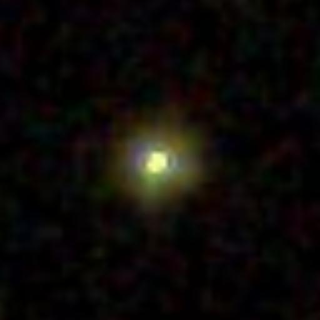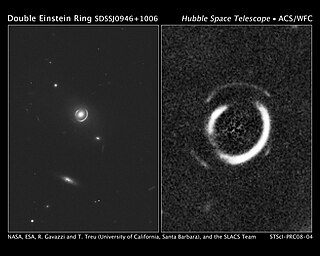 W
WThe Sloan Digital Sky Survey or SDSS is a major multi-spectral imaging and spectroscopic redshift survey using a dedicated 2.5-m wide-angle optical telescope at Apache Point Observatory in New Mexico, United States. The project was named after the Alfred P. Sloan Foundation, which contributed significant funding.
 W
WMalin 1 is a giant low surface brightness (LSB) spiral galaxy. It is located 1.19 billion light-years (366 Mpc) away in the constellation Coma Berenices, near the North Galactic Pole. As of February 2015, it is the largest known spiral galaxy, with an approximate diameter of 650,000 light-years (200,000 pc), thus over three times the diameter of our Milky Way. It was discovered by astronomer David Malin in 1986 and is the first LSB galaxy verified to exist. Its high surface brightness central spiral is 30,000 light-years (9,200 pc) across, with a bulge of 10,000 light-years (3,100 pc). The central spiral is a SB0a type barred-spiral.
 W
WPHL 293B, also known as Kinman's dwarf, is a low-metallicity blue compact dwarf galaxy located about 22.6 Mpc from the Earth in the constellation Aquarius.
 W
WSDSS J0927+2943 is an unusual quasar. It exhibits two sets of optical emission lines with different redshifts. The origin of the two emission line systems is believed to be a gravitational wave recoil event: the ejection of a supermassive black hole from the center of the host galaxy. In this interpretation, one of the emission line systems originates in gas that is bound to the black hole, while the other set is associated with gas that remains in the galaxy.
 W
WSDSS J1106+1939 (SDSS J110644.95+193930.6) is a quasar, notable for its energetic matter outflow. It is the record holder for the most powerful matter outflow by a quasar. The engine is a supermassive black hole, pulling in matter at the rate of 400 solar masses per year and ejecting it at the speed of 8,000 km/s. The outflow produce a luminosity of 1046 ergs. This makes the quasar more than two trillion times brighter than the Sun, one of the most luminous quasars on record. The quasar has the visual magnitude of about ~19, despite its extreme distance of 11 billion light years. The outflow of matter from the quasar produces about 1/20 of its luminosity.
 W
WSDSS J001820.5–093939.2 or SDSS J0018−0939 for short is a star system approximately 1000 light-years away near the constellation Cetus.
 W
WSDSSJ0946+1006 is an unusual gravitational lens system consisting of three galaxies at distances of respectively three, six, and eleven billion light years from Earth. In a report presented at the 211th meeting of the American Astronomical Society, researchers Raphael Gavazzi and Tommaso Treu of the University of California, Santa Barbara described the discovery of a double Einstein ring produced by the gravitational lensing of light from two distant galaxies. The observations were made using the Hubble Space Telescope.
 W
WUS 708 is a hyper-velocity O class subdwarf in Ursa Major in the halo of the Milky Way Galaxy. One of the fastest-moving stars in the galaxy, the star was first surveyed in 1982.